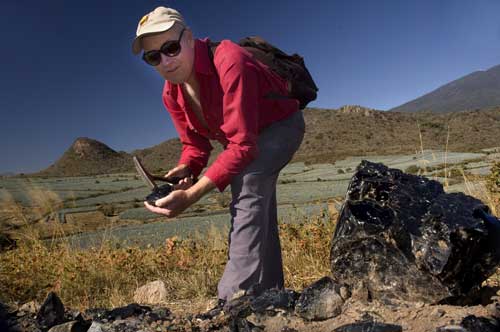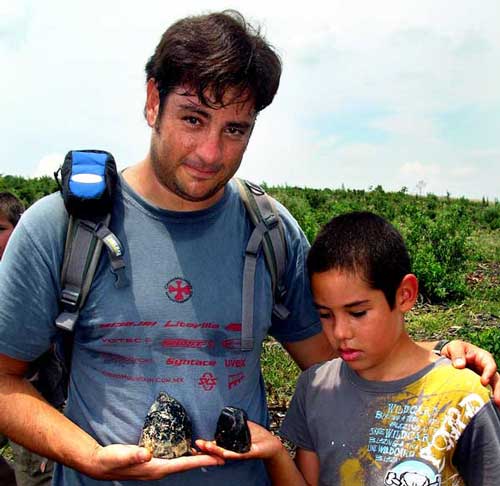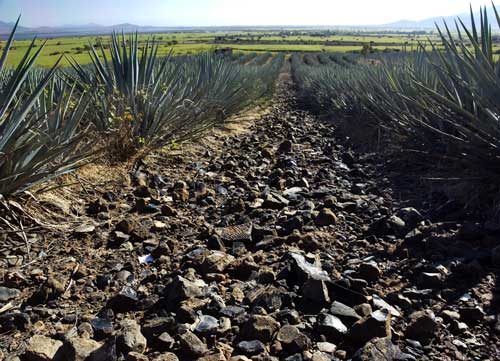 The state of Jalisco has the third-largest deposits of obsidian in the world.
The Ancient rulers of the Teuchitlán Nation, which dominated western Mexico for
at least 1700 years, found that the very purest obsidian could be found in two
large deposits: La Joya and El Pedernal.
Some years ago, my wife Susy and I became friends with archeologist Rodrigo
Esparza, whom we quickly named The Obsidian Detective because of his particular
talent for identifying the origin of obsidian artifacts through a procedure
called Neutron Activation Analysis. “When are you going to take us to La Joya or
El Pedernal?” we asked him one fine day.
The state of Jalisco has the third-largest deposits of obsidian in the world.
The Ancient rulers of the Teuchitlán Nation, which dominated western Mexico for
at least 1700 years, found that the very purest obsidian could be found in two
large deposits: La Joya and El Pedernal.
Some years ago, my wife Susy and I became friends with archeologist Rodrigo
Esparza, whom we quickly named The Obsidian Detective because of his particular
talent for identifying the origin of obsidian artifacts through a procedure
called Neutron Activation Analysis. “When are you going to take us to La Joya or
El Pedernal?” we asked him one fine day.“Well, I’m tied up this coming weekend,” he replied, “but you could go to El Pedernal on your own; it’s only two kilometers from Teuchitlán.”
So, a few days later, we piled into a station wagon and headed for the Teuchitlán cemetery, north of which, according to Rodrigo, we would easily find El Pedernal, which is “so big you can’t possibly miss it.”
Well, three kilometers north of the cemetery, we came to a wide clearing and parked. “This must be it,” I said and we all piled out and started hunting for obsidian. Amazingly, however, we were unable to find more than a few specks of the famous natural glass. So, we figured, El Pedernal must be further ahead and, indeed, we found that the dirt road continued on the other side of the open area. At that moment, a truck came along.
“We’re looking for El Pedernal,” we said.
“Never heard of it,” they answered. “But if you’re interested in the local garbage dump, that’s where this road goes.”
We checked it out and sure, enough, the road led straight into the middle of great heaps of smoldering refuse.
“This couldn’t possibly be the right way,” declared my wife Susy, holding her nose, and back we went to the clearing where the only obsidian we found was in the form of tiny crumb-sized bits of black, scattered around an anthill.
Finally, we gave up, got back into the car and discovered we were thoroughly stuck in the mud. In the process of pushing the car to a dry spot, we all ended up covered with chocolate-colored slop. You could say our search for El Pedernal did not exactly get off to a great start.
Back at home, we called up The Obsidian Detective and told him our sad story. “¿Cómo?” he exclaimed, “You were exactly in the right place! All you had to do was drive through the garbage dump and there, on the other side, why that’s El Pedernal.”
Our subsequent visits to this site were far more fruitful. We discovered it is truly chockfull of obsidian, the results of two separate lava flows, over 65 million years ago, from Tequila Volcano, which looms on the horizon only nine kilometers to the north.
El Pedernal covers four square kilometers of mostly flat land from which some 40,000 cubic meters of obsidian were extracted over the centuries. Archeologists have catalogued no less than 217 obsidian mines here, but be careful. They don’t look at all like the typical mines of the old west. The obsidian is so plentiful here that the ancient people of Teuchitlán never had to dig a pit or trench more than four meters deep to find all the material they needed, so today, most of these mines resemble slight depressions in the terrain.
Beside mines, you will also find numerous obsidian workshops at El Pedernal. As with the mines, these may not match the image in your mind’s eye. In fact, you may have already walked past a thousand-year-old obsidian workshop while strolling in the Primavera Forest without even knowing it. What you often see is simply a concentration of obsidian rubble covering a roughly circular area often with a diameter of only ten meters.
 In such places, ancient craftsmen sat, perhaps with a deer-horn punch in one
hand and a round basalt stone (for a hammer) in the other. On a flat, hard
surface between their legs they would place a cone-shaped obsidian core, which
also had a flat bottom. A tap in the right spot would fracture the natural glass
and, of course, the skill was to split the obsidian in exactly the right place,
to produce a prismatic blade with an edge sharper than the finest surgical
scalpel. The cores, of course, came from the obsidian mines. A large chunk of
obsidian would be taken out of the ground and, if the material was of good
quality, it would be worked into a bell-shaped core, which might then be
transported far away to a more sophisticated workshop.
At El Pedernal we have found obsidian cores and an abundance of half-formed
blades, arrow heads, etcetera, as well as countless pottery shards. We have also
come across obsidian of various colors, such as chocolate, grey and “bile
green.” According to Rodrigo Esparza, there are also deposits of bright red,
yellow and other rare colors, but these are difficult to find. If, however, you
are hunting for black obsidian to decorate your garden, come visit El Pedernal.
You’ll probably trip over a big chunk of the stuff the moment you step out of
your car.
In such places, ancient craftsmen sat, perhaps with a deer-horn punch in one
hand and a round basalt stone (for a hammer) in the other. On a flat, hard
surface between their legs they would place a cone-shaped obsidian core, which
also had a flat bottom. A tap in the right spot would fracture the natural glass
and, of course, the skill was to split the obsidian in exactly the right place,
to produce a prismatic blade with an edge sharper than the finest surgical
scalpel. The cores, of course, came from the obsidian mines. A large chunk of
obsidian would be taken out of the ground and, if the material was of good
quality, it would be worked into a bell-shaped core, which might then be
transported far away to a more sophisticated workshop.
At El Pedernal we have found obsidian cores and an abundance of half-formed
blades, arrow heads, etcetera, as well as countless pottery shards. We have also
come across obsidian of various colors, such as chocolate, grey and “bile
green.” According to Rodrigo Esparza, there are also deposits of bright red,
yellow and other rare colors, but these are difficult to find. If, however, you
are hunting for black obsidian to decorate your garden, come visit El Pedernal.
You’ll probably trip over a big chunk of the stuff the moment you step out of
your car.How to get there
You need a high-clearance vehicle for this. From the Guadalajara Periférico, take highway 15 (Nogales and Tepic) 25 kilometers to highway 70 which heads southwest towards Ameca. Now go about 18 kilometers until, just past the Tala sugar refinery, you see a sign for Ahualulco. Turn right. This road will take you 12.7 kilometers to the Teuchitlán gas station.
As for finding El Pedernal, first repeat to yourself the words “It’s so big I can’t possibly miss it.” Then Drive 522 meters past the Teuchitlán gas station and turn right, immediately after the cemetery. Set your odometer here. Now go north through the town and 900 meters from the highway turn left onto an unimportant-looking dirt road. Go northwest on this, “following the main drag” until you come to a spot 2.8 kilometers from the highway. Here take the closest sharp right. At 2.9 kilometers you should be passing a pump house. If so, jump for joy, for you have nearly arrived. If you are somewhere else, you’ll have to start asking, “¿Dónde está el basurero? (Where is the garbage dump?). After driving through the dump, you’ll find a nice parking spot at 3.5 kilometers from the highway. You are now standing at the south end of El Pedernal obsidian deposit. Driving time from Guadalajara: about one hour and twenty minutes.
